
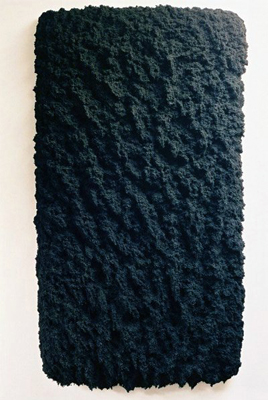
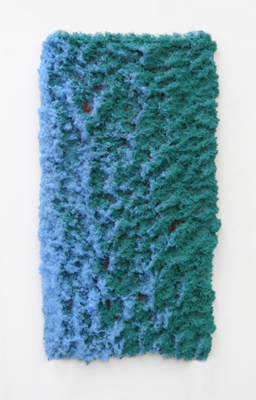
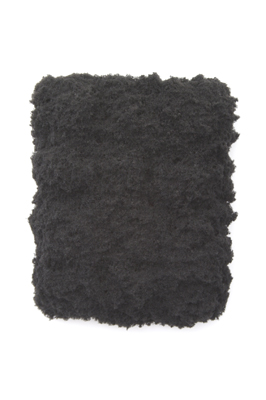
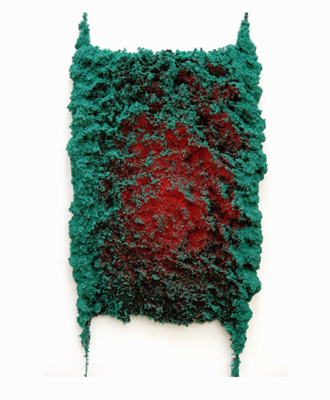
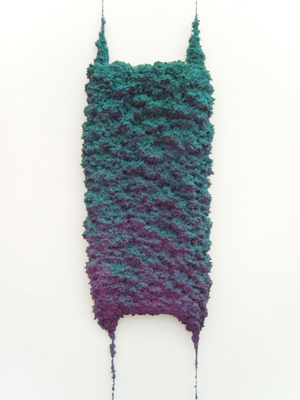

Karl Ernst Osthaus Museum Hagen
Untitled KB Series, 2006,
flocculated paper, 130 x 70 x 15 cm
Untitled KB Series, 2007,
flocculated paper, 41 x 22 x 2 cm
Untitled, KB Series, 2007,
flocculated paper, 30 x 30 x 7 cm
flocculated paper, 48 x 28 x 4 cm
flocculated paper,67 x 25 x 5 cm
flocculated paper, 160 x 120 x 8 cm
| 1947 | born in London |
| 1971/ 1975 | Studied at Saint Martin’s School of Art |
| 1977 | University London |
Collections
Karl Ernst Osthaus-Museum, Hagen
Leopold-Hoesch-Museum, Düren, Germany.
| Solo Exhibtions | |
| 1998 | In-Situ. Installation at the Dependence Gallerie, Maria Chailloux, Amsterdam |
| 1988 | Prema. Uley, Dursley, Gloucester |
| 1987 | The Gallery, The London College of Furniture |
| 1986 | Parkway Focus Gallery, London |
| 1986 | Verein fuer Aktuelle Kunst e.V., Oberhausen |
| 1985 | Vortex Gallery, London |
| Selected Groupshows | |
| 2008 | Art Karlsruhe, Classical, Modern and Contemporary Art - Galerie Jochen Holtje, Tübingen Germany - Selected works from KB Series |
| 2007 | Kunst 07 Zurich (Oerlikon). 13. Internationale Messe fur Gegenwartskunst - Galerie Jochen Holtje, Tübingen, |
| 2005 | Lebendiges Grau, Karl Ernst Osthaus-Museum, Hagen |
| 2004 | Die Farbe hat Mich II, Karl Ernst Osthaus-Museum, Hagen |
| 2003 | Seeing Red – An International Exhibition of Non-objective Painting, Hunter College Times Square Gallery, New York |
| 2002 | Colour: A Life of its Own, Kunsthalle Mucsarnok Budapest |
| 2000 | Farbzeit, Verein fur Aktuelle Kunst Oberhausen |
| 1998 | Clear and Saturated, Arti et Amicitiae, Amsterdam. |
| Colour Matter Energy III Gallerie Maria Chailloux, Amsterdam | |
| 1995 | Verschijning (Internationale hedendaagse kunst), Bergkerk Deventer |
| Erscheinung, Leopold-Hoesch-Museum, Düren | |
| Colour Matter Energy II, Verein für Aktuelle Kunst e.V. Oberhausen | |
| 1993 | The Gallery at John Jones |
| Kunstrai (Art Fair) Gallerie Maria Chailloux, Amsterdam | |
| Art in Boxes, England and Co., London | |
| 1992 | Colour Matter Energy, Galerie Maria Chailloux, Amsterdam |
| 1990 | European Art, The Metropole Arts Centre, Folkestone, |
| De Ruimte, Liesbeth Lips, Amsterdam | |
| 1989 | Cultural Centre, Famagusta Gate, Nicosia |
| Bildgrund, Städtische Galerie Lüdenscheid | |
| Bildgrund, Städtisches Museum Mülheim/R | |
| 1987 | Critic’s Space 4, Selected by Paul Overy, Air Gallery, London |
| 1986 | First International Biennale Der Papierkunst, Leopold-Hoesch-Museum, Düren |
| 1982 | Hayward Annual - British Drawing, Hayward Gallery, London |
| Statement |
| The process The flocculated works are made of paper that is forcefully disintegrated. The dry atomised particles are propelled in a relatively controlled flow and collect (flock) together on a surface. The particles are then fixed in their state of suspension. The flocculated works are the closest I get to realise ‘how it is made is what it is’. Several of my essays have been published: ‘Blau, Kaleidoskop einer Farbe’ (1990) for the Heidelberger Kunstverein, Germany. ‘Clear and Saturated’ (1998) for the catalogue and exhibition of the same name for ‘Arti et Amicitiae,’ Amsterdam, The Netherlands. |
Clear and Saturated
In the tradition of 'Arti et Amicitiae,' an artist, Jo Heijnen is the curator of this exhibition which he has entitled 'Clear and Saturated’ He asked me, an artist, to write this introduction. My viewpoint to history/the history of art is that of an artist. My concerns are subject to the limitations of my endeavours to locate myself as a maker in the world in which I live.
All of the artists included in 'Clear and Saturated' have lived and worked in the 'Western Block' and are of the post war generation. How is it that these artists, quite independently, from different countries, speaking different languages, coming from different social and educational backgrounds, have arrived at making monochromes today?
The formative experiences (and therefore the points of departure) of this post-war generation, are significantly different from their immediate predecessors. The differences in their perception of reality, their truth, have developed in a significantly different ethos.
Many of the artists have expressed their difficulties with the way their works are perceived. Often they feel the power of their work is abrogated by being contextualized inappropriately. The difficulties experienced with context are significant because I believe it is precisely this dialogue which has influenced and defined the limitations of the work. This is the point of contact where the 'relationship' is exposed and defined. I feel these influences have more to do with the arrival of this generation's work ethic than the concerns of contemporary aesthetics can define.
The backdrop against which our works are seen is a culture where science, technology and the media are the dominant and most pervasive determinants. I am particularly interested in how the meaning of language, visual and otherwise, is changed in context, how it is influenced by means of dissemination and how this understanding of the malleability of language has been harnessed by political creeds in the 20th century. Today it is impossible to sustain the idea, that art, (even mute monochromes?) can be a-political and that anyone who deals with 'The Language' can be. (Extreme right wing and left wing political forces despise abstraction and anything which appears to be a-political is viewed as threatening). Today anything could be changed in context, demonstrated in the art world 'a la Marcel Duchamp', whether urinals or monochromes. I feel it is the use and abuse of language that has contributed to our contemporary sense of the impossibility of communication, and that it has played an integral part in these artists' arrival. These artists' special sensitivity to material-colour is what differentiates their work from earlier generations. If art has anything to do with making sense of our experience than it cannot be isolated from the context in which it is made or seen.
I approach this survey with a sense of an imperative realisation that these artists are of the first Post World War generation to have come of age. As we approach the 21st century we become increasingly conscious that the 20th century societies we have been nurtured in, have been determined by issues which emanated from traumatic events that occurred before our time. Ours is the 'Cold War' generation, the first atomic generation and the first global multi-media communications generation, to name but a few firsts. We have witnessed the struggle of black people for civil rights and the impoverished peoples of the World fighting against the inequity caused by what Gandhi encapsulated when he said "the earth has enough for everyone's need, but not for everyone's greed." There are those of us before the bomb and those after.
Nothing will be the same again, not even that which appears to be can be. Can something be salvaged from the past to allow us to continue, can we build a bridge over the debris to reconnect our fragmented psyche? Universality its brave hopes, the International Style after the 'final solution' is unconscionable. Development and progress are our society’s aspirations, our justifications, our hopes, our excuses! But is there not something wrong with a concept of progress that threatens survival itself. Man has demonstrated the unthinkable, the technology to destroy our planet. The Cold War may be over but not the cold reality. It becomes clear that an alternative relationship with the physical world must be sought, a different way of being with it. There is a heightened awareness in the handling of materials because of their potentially destructive power, their atomic and economic power. The growing liberation of women in the late 20th Century has had a profound influence on the fundamental fabric of western culture. In the arts a generation of women has come to prominence, some of whom are showing in this exhibition. Ours is an age of rapid change, driven by science, technology and the media; it is the age of religious uncertainty and of politically institutionalised paranoia (now threatening the democracies they were designed to secure). The icons we still identify as our precursors are Einstein, Freud and Marx but I could also add Nietzsche, and on the other side of the spectrum Max Ernst, Nelson Mandela and of course Gandhi.
Social Realism
In the late sixties up to the early eighties the young artists exhibiting here began their research. They found themselves identifying and assimilating the dominant abstract art movements which had directly preceded them. Abstract art had reached sufficient maturity and exposure by the mid seventies, to allow for clear distinctions to be identified between its various branches. One of the main influences at that time was the field paintings of the Abstract Expressionists. These artists worked to define the implications of abstraction, feeling its liberating potential but found themselves increasingly isolated, particularly in the eighties. In spite of the Cold War in the sixties a narrow gap opened up for a creative dialogue to ensue before the ethos of a reactionary backlash took hold. This was seen in the clamp down by the authorities in connection with civil rights and Vietnam and in the 1968 student uprisings in Paris. In the sixties, the reaction against Abstraction had already started with Pop Art. The American government agencies’ failure to sustain the illusion of a liberal culture which it projected after the war, had disastrous consequences for many artists; when reality outran the myth and it collapsed around them.
In the booming economic climate of America and Britain in the 'Swinging sixties' Andy Warhol, Lichtenstein and Peter Blake led the way in ironically celebrating the consumerism of the 'American Dream'. They employed the language and the materials of mass production; advertising, reproducibility and the media. A stark contrast emerged between the social realist issues that 'Pop Art' addressed and abstract art, which ironically was identified with the art Establishment and was seen as esoteric and elitist. How the Abstract Expressionist and other 'avant-garde' Modernist movements became identified with the Establishment is informative.
In Russia after the Revolution their abstract revolutionary artists were usurped by Stalin's creed of 'Socialist Realism' and their works were proscribed. Those who were booted out in the 1930s joined forces with German and Dutch 'isms' and creeds,
Russian Suprematism and Constructivism met Dutch Neoplasticism, De Stijl and the German Bauhaus -a formidable cocktail. What constituted 'Modernism' was further besmirched through association and collaboration during the war. This was partly due to modernism's propensity to proselytize an ideology. Their 'brave new world' would be constructed by artists, architects, intellectuals and mystics. Their pursuit of utopian answers and absolutes (the 'International Style' the 'Bauhaus' etc), were subsumed by the puritanical and malign ambitions of another utopian political creed, 'The Third Reich', which the Nazis replaced with their Socialist Realism. It was against this backdrop after the war that an abstract art movement for the first time 'qualified' to become the propaganda tool of a new emergent power, the USA. The CIA was set up in 1947 and covertly promoted the Abstract Expressionists in opposition to communist Socialist Realism, and at once distanced themselves from the extreme right wing forces at home and abroad. To these ends they appropriated European arts and artists which they deemed suitable and marginalized those which were not. European artists during the late fifties and sixties whose work differed from the CIA's creed were excluded from the now dominant American art market, its global communications network, and its channels of propaganda and thus were contained. In England the St Ives group whose influence on the Abstract Expressionist was profound were for that very reason marginalised. The CIA's remit was that the Abstract Expressionists were to be a uniquely home grown product. Others were virtually invisible outside of their own countries while Yves Klein, members of the Zero Group and Joseph Beuys' alternative visions were contained. It becomes clearer how much of that influential culture has been based on appropriation and how much of our culture in our time has been marginalised and disjointed through interpretation of it led by the American intelligentsia.
Given this history, how is it that these artists continued to pursue their visions, towards these 'Clear and Saturated' ends?
The power of the way we see ourselves
Today the parameters of what an artist is and the legitimacy of their concerns are under constant scrutiny. In this century artists have been required to address themselves to the fundamental questions first raised by photography and to constantly redefine the parameters of their concerns against its technological developments. Notions of veracity have been challenged. Today uncertainty in our perception has made perception itself the focus. We take a position determined by attempting to locate ourselves in relation to the age in which we live. Artists are required to access the media and the resources of marketing and are encouraged to compete in its 'star system'.
The impossibility of communication
'The media' may be 'the message' but it is an intolerable one. Mass production necessitates mass consumerism. Our capitalist culture is advertised through the now global popular media. The message promoted by the media increases our material needs rather than answers them at a terrible cost to those disenfranchised. The 'want industry's' answer to our searching is always more, more of the same. The economic system with its promises of ever increasing material wealth is coupled ironically or cynically with promises of increased security. The price tag is that we continue to play the game. In other words we must be always and in all ways less than what we are. The objectives of propaganda have never been different except that now technology has made it all pervasive. It interprets and reinterprets history at will to validate its own interests. Its content is subliminally locked in the language which is structured to celebrate the cultural values of our time. This unrelenting message fills our waking and dreaming space. The 'language' cannot be opposed in its own terms, when its very substance expresses and converts whatever is said back to material which can only reverberate the same message.
Contemporary advertising and propaganda have learnt from and utilized the arts more than in just the obvious ways. High art has been used to enrich by association its mundane material products. Advertising / propaganda utilises an understanding of the underlying message of artists whose work itself represents that material and structure, thus becoming a more powerful level of communication which overrides the superficial, idiosyncratic and circumstantial. The CIA's clandestine use of the Abstract Expressionists' work as propaganda has coloured our perception of it. But propaganda never lasts beyond its time and it seems that 'that time' is running out. In being stripped bare of their propaganda purpose we begin to view these works from a different perspective and what is substantive becomes apparent. A work of art may be at the same time autonomous and also on another level be experienced as part of a greater entity, a parallel nature where its validity is beyond the art world's capacity to define it. Viewed thus it is beyond any utilitarian use to which it may be put, or of any content with which it is imbued when appropriated as propaganda. These associations are powerful, but temporary and never completely pervasive. The experience of a work of art is a personal one, which takes place within the silent eye of the beholder. A work is not valued or differentiated on this level. By its speciality, representational, abstract or concrete, an artist's work is formulated by what is possible within the time he or she lives; it is all she or he can do. At best it connects and touches that which is common to both maker and viewer; affirming the creative levels of the human spirit, beyond, above and below any linguistic transformation giving credence to Gaston Bachelard's assertion that, 'art is an increase of life!'
This is the context in which the combat with contemporary alienation takes place.
The dumb monochrome
In the personal combat with alienation is the necessity to engage, to move the feeling to reconstruct. To act with the actual stripped of notional crutches. Uncertainty in our perception of ourselves makes perception itself the focus.
This is the context within which this generation of artists has set about determining an alternative means to evaluate access and validate their own critical awareness. To affirm their perceptions has necessitated clear differentiation from past and present language and its modes of exposure. This has required the development of an independent viewpoint leading to a process of informed elimination through practice which was not theoretical but actual and thus personally affirmative. Therefore the choice of material and process come under careful scrutiny by these artists, who are aware that means cannot be divorced from ends. They are conscious that this divorce is precisely the cause and effect of an unacceptable increase of the levels of fragmentation and alienation that we experience today. The works are not systematic nor do they lend themselves to metaphorical interpretation. They share a resistance to use their work to impose opinions/explanations of the world or part of it and in that sense to avoid 'saying' anything. Language has been stripped of its creative potential. These works eliminate description for the sake of relationship. So alternative is their vision, in what they awaken in our perception that they appear to occupy a parallel reality. The material reveals the immaterial through exclusion of all other: the invisible is manifest.
The concrete works of the artists in 'Clear and Saturated’; (unlike the Abstract Expressionists) exclude allusions to an elsewhere either notional or actual.
I prefer to use the alternative term. ’concrete' to differentiate the works arrived at by these artists from those of earlier generations, beginning with Van Doesburg in the 1920s when the term was interchangeable with abstraction; located in time, these works being 'on top' of 'abstraction' may now properly be seen as 'concrete'.
These works occupy space rather than describe it.
These paintings do not reflect the world but occupy it. This implies interdependence with the context in which the work is seen. Such a description speaks of an interrelatedness hitherto identified more with sculpture and architecture. Some of the works made by these artists occupy an area somewhere between painting and sculpture; coloured low relief objects simple geometric structures but all levels of three dimensionality are structured to enhance the experience of colour thus inverting the tradition. (Sometimes I feel that we are compensating by making paintings which are more physically present because our perception of space feels flatter.) These artists in accessing the most intimate levels of sensibility tuned through discipline and practice bring them to a clear position that allows for the recognition of the most intimate levels of colour vibration. These works cannot be separated from our environment and thus are not contained immutable entities. They are changed in context within their limitations and constantly changing in relationship to the eye of the viewer both optically and psychologically. They cannot be isolated without losing their energy.
Our concentration is turned to focus on our personal relationship with the material in real time and actual space with all its joys and sorrows. This experience brings us closer to the pulse of our time in which we attempt to develop an independent critical basis of engagement. We work towards developing methods of working which allow for the employment of primary gesture and touch an affirmative experience of our reality our humanity towards feeling. Here we find accord with Mondrian's insistence that his practice preceded theory and the intuitive preceded the rational. In this process is found affirmation in the organising force of our will to form towards consciousness sentiency. Thus to release the cognitive power of our imagination the visceral becomes tangible. Each artist has made sense of their experience which has been validated in their practice. Many art critics' and historians' concentration on formalist aesthetics further undermines the impact of these works. These individuals are not 'Monochrome' artists any more than they are 'Modernist' or 'Post Modernists' artists. Each individual has engaged in a deductive process of elimination to a personally essential not 'Minimalist' definition. The monochrome has been arrived at because it has the most resistance to interference for the artist and viewer - already dumb it can not be muted.
These artists are material realists
The properties of these monochromatic/field paintings which make them impossible to reproduce in any meaningful way further define their concreteness. These works render meaningless any form of simulation. This exclusion from being defined by contemporary media is of primary significance. These artists’ works are not amenable to the reproductive resources of the media and thus resist being subsumed by it. The materiality of these artists' works is resistant to the media its form and message, its virtual reality and its virtual democracy. These concrete works can only be accessed in real time and space in an intimate relationship with the viewer. Realism takes on a new meaning in this cultural context. These 'things' cannot be appropriated by the prevalent language, they defy categorisation. They remain 'subject', never morbidly reduced to objectified 'other'. In their mutable clarity they live only now in the presence of the beholder. They are the subject matter which can only be experienced in the 'concrete' present. The present is all there is. In reproduction, scale and surface qualities which are so important to the experience of the actual works are lost, the colour stultified. These works reveal themselves in actual time: there is no reproducible after. These monochromes are stripped of any internal surface dialogue. There is no 'figure on ground' debate here for the work is the figure and the world is its ground. Where a device is used to separate or cause disturbance across the surface it is done to enhance optical properties of the colour field overall and thus is not a hierarchical division. These works demonstrate a sense of reality where time, light and energy are indivisible. Each artist is working to identify the personal limitations that they have determined as integral; to attempt to make means and ends indivisible.
Pierre Restany articulates Yves Klein's objective ....no longer to express the appearance of the object but to 'operate' in such a way that the object is expressed in itself". These works are here 'just now', as present now as they were in the 'now' of their making. Many of the artists have chosen to adopt unusual materials and tools, or adapt traditional ones in order to tap into other territories. This involves a much greater sensitivity to the limitations of materials. How materials are handled and how they are touched and applied becomes integral. Truth to materials takes on a different dimension. Many of these artists have arrived at a 'mono-action' to produce their monochromes a singular, often repetitive gesture, the repetition producing a kind of simple grid simultaneously. These works are made by employing flooding, layering, glazing, scratching, dropping pigment or other material, spraying, applying paint using rollers brooms, power tools etc -sometimes even brushes are used!
These artists are Material Realists who are aware that the hierarchy of materialism must be acknowledged. It must be dealt with on its own ground, for it is their own.
The significance of quantum mechanics - 'permanent uncertainty'
W.F.Heisenberg sums up the impact on us of the wave and particle observation as 'permanent uncertainty' i.e., that how we view something changes it. The implication behind this observation is that there is no immutable reality and that we always have choice for which we must take responsibility and decide. The optical artist Bridget Riley wrote in an article entitled 'Perception is the medium' (Art News, New York, October 1965) "My work has developed on the basis of empirical analyses and syntheses, and I have always believed that perception is the medium through which states of being are directly experienced. (Everybody knows, by now, that neuro-physiological and psychological responses are inseparable")".
Here we find the double-edged sword of empiricism. The manner in which the artist employs these principles, embedded in the theory that all knowledge is derived from sense-experience, has led inevitably towards syntheses; which is in direct contrast to their application by scientists, which has proved to lead to division. In the hands of scientists, freed in this society from moral restraint, this ethic has been responsible for the production of ever more powerful and efficient means of destruction alongside the development of distancing mechanisms of perception to enable their use. Today the ethics of our global economic systems in applying the same distancing principles are having devastating global consequences. When artists have attempted to emulate 'scientific' methodology the problems inherent in empirical objectivity can be seen clearly in both the vapid beauty of late Impressionism and the alienated sensuality of certain forms of Realism. The application of these divisive ethics in our societies has been the cause of our contemporary alienation. The employment of distancing mechanisms of perception is responsible for the distancing of ourselves from ourselves.
A chance to breathe
The acceleration of change in society today makes it increasingly difficult to assimilate our experience. Is there a way through the language? And as inheritors of this language, what can we do against this barrage, in crisis and in constant flux? What is possible in the face of the outreach of this overwhelming communications machine which technology has made rapid and universal, pervading all our senses, invading our time and space?
Perhaps the accumulative proliferation of means of communication will make it impossible for anyone voice to control the output. Perhaps the accessibi1ity of the means of communication will democratise via the information highway and internet, but I doubt it. At best it will become a virtual democracy, a terrible cacophony from which we may need to escape to silence.
What can we decipher from the cumulative baggage of history to make sense of our experience of our lives?
What is a human being in our present context?
Can we carve out a position to view it, to make sense of it?
We can say nothing; we can not answer! We offer up silence, an empty space, an uncluttered singular and unequivocal vibration of a monochrome, perhaps the only space left to pause, to catch our breath to breathe.
This essay is offered as a text which represents another response parallel to the work which I hope both illuminates and contextualises it.
Sotirakis Charalambou
February 15/2/1998.
Blue
Today, an artist does not pick up a colour lightly, or lightly employs a process or material. We are aware that each colour is heavily weighted through association; given meaning in use, not only by visual artists, and informed by poets and philosophers etc., but also by scientists who, in developing technologies, have created a variety of new materials and instruments, which reflect, absorb and project light creating new sensations of colour and associated meanings.
In nature, blue is the most optical of colours, the most constant sensation, yet the most illusive. Few materials found on the Earth are blue, even flowers are rare and transient. Yet, all colour is overpowered by blue in time and space, in the shifting sunrays of our days. Earth bound, we look out into celestial blue. The umbrella of our world reflected in its sister sea. Blue helps us to measure distance and time, even people who are colour blind are rarely, if ever, blinded to the perception of blue. Blue which is universally associated with coolness and clarity is at once thought of as mysterious and mystical.
I am always curiously impressed by objects which are coloured blue in the urban environment in which I spend my life. On the table, as I write this letter, a plastic ultramarine cigarette lighter, holds its space. The matt cool blue paper of your letter and the metallic cobalt blue of a car body I see through the window, are at once held concretely by my knowing, through the experience of sight, touch and sign, I recognise their weight, the materials they are made of, I read their shape, articulated by the light which falls on them. But the blue invites the eye to linger. The weight of the materials is soon denied. The surface gives way and one sinks into the colour, and the mind wanders. When the object is seen in relation to the colours around it, it gives off a vibration as if trapped and makes holes in the environment, as if to escape the 'heat', like water seeking its own level.
Blue is the most challenging colour for me, because of its propensity to wander both mythically and in the psychology of our perception. I cannot confine my observations on the colour blue to art alone because some of the most significant influences on me have been made by events and developments in science and technology. The most significant experience of blue, in this respect, and probably the most intensely felt by me, was seeing photographic images of our World taken from space. Ours is the blue planet. Blue is no longer perceived to be immeasurable, signifying boundless possibilities, celestial. It becomes bound in my imagination, a finite entity a measurable commodity: a majestic blue sphere like an optical illusion, a vaporous mist catching light beams, beautiful and terrifyingly vulnerable in the vastness of the universe. It makes me conscious of the temporal and fragile eco system which we inhabit.
Yet, I cannot find a more appropriate word to describe it than, miraculous.
Many artists impress me who have worked with blue in particular Mondrian, Yves Klein, Barnett Newman, Anthony Caro, Kandinsky etc. But, the one which has made the most profound impression on me is Seurat. His use of optical colour mixing, simultaneous contrasts and the importance of process make me conscious of his coloured canvas surface as a tactile reality. Never before or since, have I been more impressed by the quality of blue which I experienced for the first time, many years ago, standing in front of his painting in the National Gallery, here in London, called 'Bathers at Asnieres' in which I sensed the infinite and the finite simultaneously, a cognition which moves me to this day. A quality glimpsed metaphysically and transcendentally in Byzantium Icons and comparable to the magic of Einstein's theory of relativity of which, of course, it predates.
Heutzutage nimmt ein Künstler nicht leichtfertig eine Farbe auf nach wendet er
eine Vorgehensweise oder ein Materialleichtfertig an. Wir sind uns bewusst,
dass jede Farbe schwer befrachtet mit Assoziationen ist, dass sie durch ihre Verwendung Bedeutung erhalt, und dies wissen wir nicht nur van bildenden Künstlern, Dichtern und Philosophen usw., sondern auch van den Wissenschaftlern, die bei der Technologieentwicklung eine Vielzahl neuer Materialien und Instrumente, welche Licht reflektieren, absorbieren und projizieren, geschaffen und so neue Empfindungen der Farbe und damit verbundener Bedeutungen hervorgerufen haben.
In der Natur ist das Blau die optischste aller Farben, der beständigste Sinneseindruck, dabei dach der täuschendste. Wenige Materialien auf der Erde sind blau, selbst die Blumen sind selten und vergänglich. Dennoch ist alle Farbe vom Blau in Zeit und Raum überwältigt, in den veränderlichen Sonnenstrahlen unserer Tage. Erdgebunden, blicken wir auf in himmlisches Blau. Der Schirm
unserer Welt, gespiegelt in seinem schwesterlichen Meer. Blau hilft uns, Entfernung und Zeit zu messen, und selbst farbenblinde Menschen sind selten, wenn Überhaupt, blind fuhr die Wahrnehmung van Blau. Das Blau, welches allgemein mit Kuhle und Klarheit assoziiert wird, wird gleichzeitig als geheimnisvoll und mystisch verstanden.
Ich bin immer merkwürdig beeindruckt van blaufarbigen Gegenständen in der städtischen Umgebung, in der ich mein Leben verbringe. Wahrend ich diesen Brief schreibe, nimmt ein ultramarine blaues Plastikfeuerzeug seinen Platz auf dem Tisch ein. Mein Wissen lässt sofort das matte kühlblaue Papier Ihres Briefes und das metallische Kobaltblau einer Autokarosserie, die ich durchs Fenster sehe, durch die Erfahrungen des Sehens, des Betastens und die Kenntnis des Zeichens erkenne ich ihr Gewicht, die Materialien, aus denen sie gemacht sind und ihre Form, die das auf sie fallende Licht hervorbringt. Aber ihr Blau lädt den Blick zum Verweilen ein. Das Materialgewicht wird bald verneint. Die Oberfläche tut sich auf, man sinkt ein in die Farbe und die Gedanken wandern. Wird der Gegenstand im Verhältnis zu den ihn umgebenden Farben gesehen, so gibt er eine Vibration ab, als sei eingefangen, und macht Löcher in seine Umgebung, wie um der "Hitze" zu entkommen, so wie Wasser sich seinen Weg sucht.
Blau ist für mich die herausfordernste Farbe, wegen ihrer Neigung, zwischen Mythischem und der Psychologie unserer Wahrnehmung umherzuschweifen. Meine Beobachtungen zur Farbe Blau kann ich nicht allein auf die Kunst beschranken, denn ich wurde wesentlich von Geschehnissen und Entwicklungen in Wissenschaft und Technik beeinflusst. In dieser Hinsicht die bedeutsamste und für mich wohl die intensivste Erfahrung des Blau, waren die fotografischen Bilder von der Erde, die vom Weltraum aus aufgenommen wurden. Unser Planet ist der blaue Planet. Blau wird nun nicht langer als unermesslich, grenzenlose Möglichkeiten kennzeichnend, als himmlisch wahrgenommen. Es wird in meiner Vorstellung eine endliche Entität, eine messbare Ware. Eine majestätisch blaue Sphäre wie eine optische Tauschung, ein dunstiger Nebel, der Lichtstrahlen auffangt, schon und erschreckend verletzlich in der Weite des Universums. Es mach! mir das temporale und fragile Echo-System bewusst, das wir bewohnen. Dennoch kann ich es durch kein treffenderes Wort beschreiben als: wunderbar.
Viele Künstler, die mit Blau arbeiten, beeindrucken mich, darunter besonders Mondrian, Yves Klein, Barnett Newman, Anthony Caro, Kandinsky usw. Aber den tiefsten Eindruck hat Seurat bei mir hinterlassen. Seine Verwendung der optischen Farbmischung, der Simultankontraste und der Hervorhebung des Prozessualen machen mir die Oberflache seiner farbigen Leinwand als eine fühlbare Realität bewusst. Niemals vorher oder nachher wurde ich mehr von der Beschaffenheit eines Blau beeindruckt, wie ich dies zum ersten Mal vor vielen Jahren, vor seinem Gemälde "Badende in Asnieres", hier in der Nationalgalerie in London erfuhr Darin spürte ich gleichzeitig das Unendliche und das Endliche, eine Wahrnehmung, die mich bis zum heutigen Tage berührt. Eine Beschaffenheit, die metaphysisch und transzendental in byzantinischen Ikonen aufschimmert und die dem Zauber der Einsteinschen Relativitätstheorie vergleichbar ist, der sie natürlich zeitlich voraus ging.
Sotirakis Charalambou
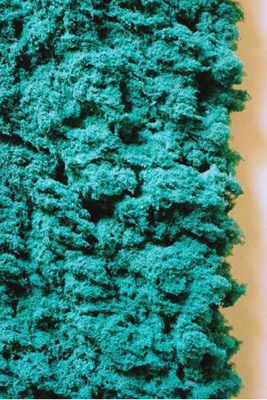
Detail of: Untitled, KB Series, 2006, flocculated paper, 160 x 120 x 8 cm